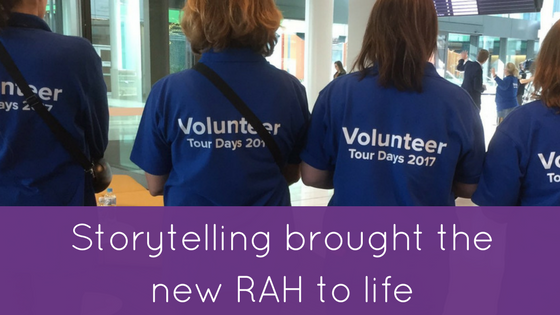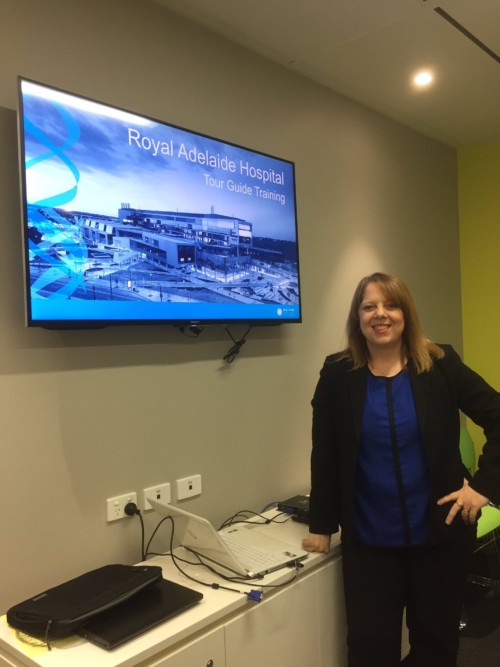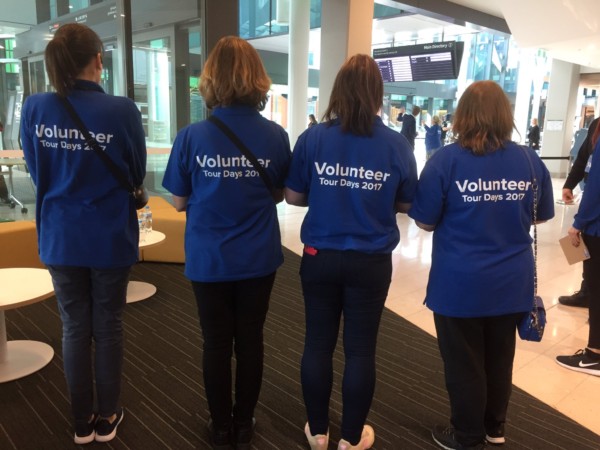We used storytelling to train SA Health Volunteers to be amazing tour guides, for the pre-opening tours of the new Royal Adelaide Hospital. Here’s why the story matters so much.
Stories – and telling stories well – can change people. When we connect emotionally with a story, it has the power to change our hearts and minds.
This is why we brought storytelling to the fore when training tour guides for the tours of the new Royal Adelaide Hospital this month. After all, if your learner remains the same at the end of the training program as they were at the beginning, then they haven’t actually learned anything.
How we designed training for the new Royal Adelaide Hospital tour guides
Training x Design was lucky to provide the training for the tour guides who are leading the South Australian community on their first glimpse of our remarkable new hospital.
The training consisted of three parts:
- An introduction, where the soon-to-be-guides learned how they can harness the power of story to create amazing experiences
- An experience of the tour itself
- A session on how to bring the story alive while also dealing with all kinds of behaviours and comments.
Over the course of two-and-a-bit days, we trained over 100 volunteers.
These amazing people who donated their time went on to lead over 5000 community members through the new Royal Adelaide Hospital just two days after training concluded.
Why storytelling?
People have been telling and retelling stories since time began. Stories pass on and help to embed traditions, cultures and values in society.
When they’re told well, stories help to form our ideas and perceptions.
When we connect with a story, sometimes we get a physical reaction. We get chills up our spines, our hearts race, we get goosebumps. We laugh, we cry and we can even feel sick to our stomachs.
Great stories can forge relationships, bring people together, inspire, and ignite.
And as a result of this experience, we can change. We might think, behave or feel differently after experiencing a powerful story.
Do you remember facts or stories?
Moving through the new Royal Adelaide Hospital is an exciting and overwhelming experience. It is large, beautiful, and fantastically well designed. There are so many interesting facts that I could create a list for you to read and memorise. But you won’t necessarily connect with facts.
What you will connect with is a story in which the facts are an important element, but not the focus. Wouldn’t you rather take a tour with a person who can tell you an amazing story throughout your journey, than with someone who just reels off data? Well, you’re not alone.
I can tell you that there are 70 gardens inside the new hospital. Or, I can tell the story of a patient who has to spend long hours in hospital because of a chronic condition. I can tell you how she has always been in fluorescent-lit, small rooms, sectioned off by other patients by just a curtain, and now can receive treatment while looking over a beautiful garden. I can tell you how her anxiety about her treatments has dropped, and how she still feels connected to the rest of the world even while she’s there.
It’s very different, isn’t it?
As the Paul Zak pointed out in his article, Why your brain loves good stories,
… my experiments show that character-driven stories with emotional content result in a better understanding of the key points a speaker wishes to make and enable better recall of these points weeks later.
Storytelling: The 5 elements of an effective story structure
So, how can you use story to your advantage? It’s simpler than you think! Every story has a structure that you can draw on to create your own great training stories.
There are different types of story structures (seven, according to author Kurt Vonnegut). But for the sake of brevity, here is a standard story outline:
- It has a beginning, a middle, and an end
- It has an ordinary, likeable and relatable main character
- The character faces a problem, challenge, or event that they have to overcome
- It amplifies the gap between the character’s current reality and what could be
- The character transforms and resolves the problem.
Combining structure with great communication helps you connect with your learners
When you combine a good story structure with effective communication and delivery, you will forge an emotional connection with the learner. Your learner will now desire something better.
As a trainer, you are a facilitator of that ‘something better’. You help your learners (your main characters) move from their current state into a different one where they engage with the learning. They hold onto it because they want that new experience.
Continuously referring to and incorporating the story throughout a learning program helps to refocus your learner on the big picture and the outcome of that learning.
We saw this during our volunteers’ training, and I have seen it as a facilitator of change over the past 20 years. It is immensely rewarding to use, and encourage others to use, stories that help to change the hearts and minds of people.
Training x Design can help you change the hearts and minds of your employees.
To learn more about how we can help you, please contact us for a confidential conversation.






Leave A Comment